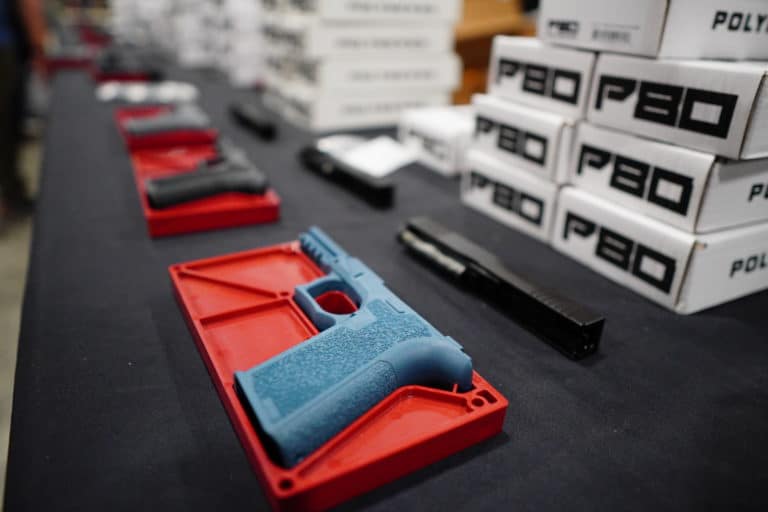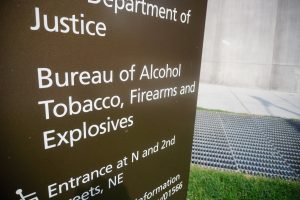The nation’s highest court considered the legality of one of the cornerstone policies of President Joe Biden’s gun-control agenda on Tuesday.
The Supreme Court heard oral arguments in the case Garland v. VanDerStok. The case centers on the legality of President Biden’s executive order requiring sellers of unfinished firearms parts kits to treat them as completed firearms by engraving them with serial numbers, obtaining federal gun maker licenses, and performing background checks on their sale. That order, which prompted a 2022 ATF rulemaking codifying its intent, relies on a more than 50-year-old statute that defines when a product is regulated firearm. The justices spent nearly 90 minutes going back and forth with attorneys on both sides of the dispute, probing where to draw the line between a collection of unfinished gun parts and a completed gun under the statute.
“Here’s a blank pad, and here’s a pen, alright? Is this a grocery list?” Justice Samuel Alito asked Solicitor General Elizabeth Prelogar. “I put out on a counter some eggs, some chopped-up ham, some chopped-up pepper, and onions. Is that a western omelet?”
“Would your answer change if you ordered it from HelloFresh and you got a kit, and it was like turkey chili, but all of the ingredients are in the kit?” Justice Barrett said, following on Alito’s analogy.
The executive order that inspired the 2022 ATF rule marked the first of many by President Biden aimed at testing the outer bounds of unilateral restrictions on gun rights without Congressional action. He quickly followed the so-called “ghost gun” rule with others that reclassified guns with stabilizing braces as heavily regulated short-barrel rifles, formally created a cabinet-level office headed by Vice President Kamala Harris to promote and coordinate gun-control efforts, and expanded when used gun sellers must obtain federal firearms licenses and conduct background checks. His administration also vigorously defended the Trump Administration’s unilateral ban on bump stocks, which the Supreme Court struck down as an unlawful extension of the ATF’s authority earlier this year.
Unlike the case involving former President Donald Trump’s bump stock ban, however, the Justices on Tuesday seemed more receptive to Biden’s rule.
“What is the purpose of selling a receiver without the holes drilled in it?” Chief Justice Roberts asked Peter Patterson, the attorney representing those challenging the rule.
“Drilling a hole or two, I would think, doesn’t give the same sort of reward that you get from working on your car on the weekends,” he added after Patterson noted that hobbyists often gain a sense of enjoyment from amateur gunsmithing with unfinished parts kits.
A favorable ruling from the conservative-leaning court would be a significant victory for the Biden Administration. It would not only preserve one of the President’s signature gun policy initiatives, but it would also mark a deviation from the Court’s recent string of decisions curtailing his administration’s latitude in reinterpreting federal law by executive action.
The Biden Administration and its allies in the gun-control movement have made cracking down on unserialized and privately manufactured firearms a key priority in recent years, particularly as their popularity among those who can’t legally own guns has ticked up. Solicitor General Prelogar presented that case to the justices Tuesday.
“There was a 1,000 percent increase between 2017 and 2021 in the number of these guns that were recovered as part of criminal investigations,” she said. “And it makes perfect sense because the whole reason why you would want to get your hands on one of these unserialized, untraceable firearms is if you are a prohibited person or you want to use that gun in a crime.”
She argued that the new rule represented a straightforward interpretation of the language in the statute meant to capture parts that could be “readily converted” into a firearm.
“It’s hard for me to see how a weapon parts kit doesn’t fit within that plain language because, quite literally, the kit is intended and designed to produce that functioning weapon in a very short amount of time by people who don’t know anything about guns and can do it with relatively little skill,” she said.
By contrast, Patterson argued that the rule was anything but a straightforward reading of the law. Instead, he said it marked a departure from decades of agency interpretation regarding when a part moved from unfinished to a completed firearm.
“There definitely has been a sea change by the agency here,” he said. “What the agency said in the [2021] Syracuse litigation was they said: ‘An unfinished frame or receiver does not meet the statutory definition of ‘firearm’ simply because it can be designed to or can readily be converted into a frame or receiver.’ That’s the exact standard they’ve now adopted.”
He argued that the ATF previously considered whether “critical machining operations” had taken place on an unfinished frame or receiver before determining whether it would be considered a firearm under federal law and that such an approach was more in line with the statute.
That argument, however, was met with skepticism from even some of The Court’s conservative majority.
“But it doesn’t appear in the statute,” Justice Barrett said. “It seems a little made up, right, the critical machining test?”
Despite the tenor of Tuesday’s oral argument, the ATF’s ghost gun rule has fared poorly in court challenges thus far. A US district judge in Texas struck down and vacated the rule last July after finding the ATF exceeded its authority under federal law. A three-judge panel for the Fifth Circuit Court of Appeals mostly upheld that decision later that October.
Notably, the Supreme Court has already weighed in on the case twice before through its emergency docket, each time issuing a stay on those lower court rulings to allow the ATF’s regulation to remain in effect while the case continued to work its way through the appeals process.
The Supreme Court will issue its final decision on the matter by next summer.






